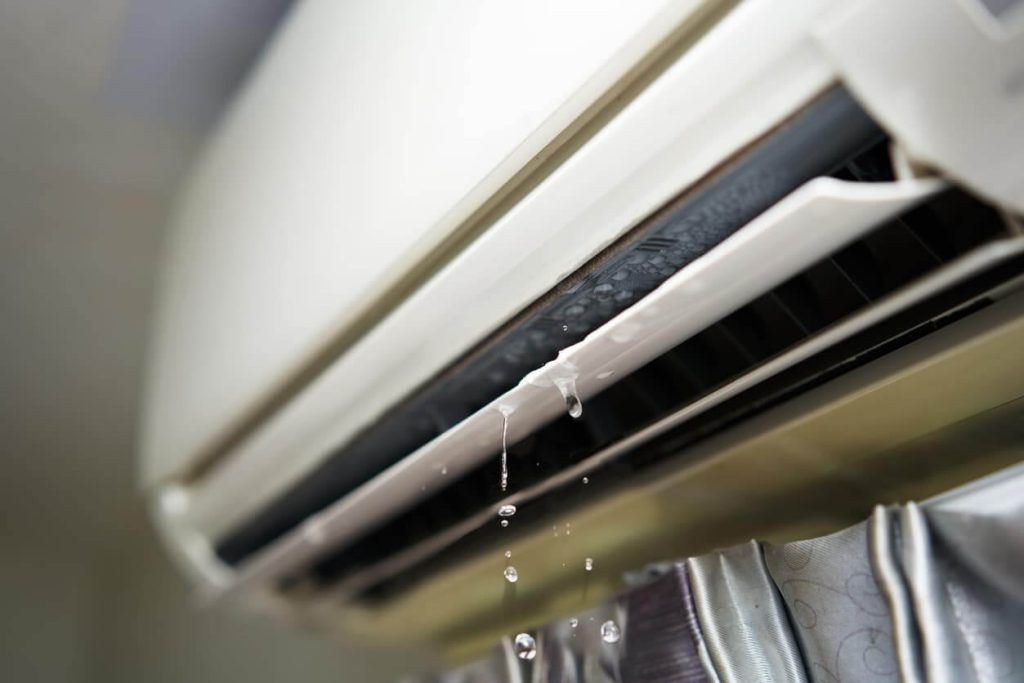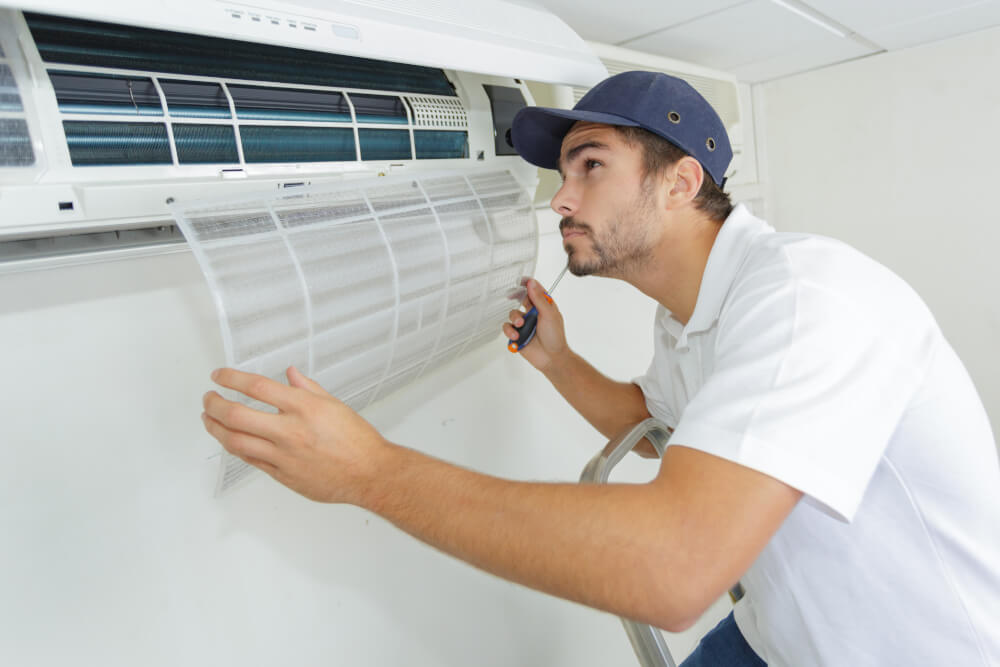Fixing Water Leakage: Proper Maintenance of Your Air Conditioning System
Air conditioning is an essential part of daily life, helping us maintain a comfortable and cool environment in hot weather. However, a common issue when using air conditioning systems is water leakage, which can be troublesome and potentially damaging to the system. To avoid this issue and ensure your air conditioner operates efficiently, regular maintenance is crucial.

Cause of Water Leakage from Air Conditioning:
- Blockage in the Drainage System: One of the primary reasons for water leakage from an air conditioner is a blockage in the drainage system. During the air cooling process, the air conditioner generates cold temperatures, causing moisture in the air to condense into liquid water. The drainage system needs to continuously remove this water from the air conditioner through a drainage pipe. If the drainage pipe is clogged with dust, debris, or contaminants like bacteria or mold, the water cannot escape, leading to water leakage.
- Incorrect Temperature Settings: Setting the air conditioner at too low a temperature can result in excessive condensation. This occurs when the surface temperature of the air conditioner is lower than the dew point temperature. When humid air comes into contact with the cold surface, water condenses and may drip down, causing leakage.
- Faulty Water Seals or Drain Pans: Air conditioners consist of various seals and drain pans to ensure that cold air remains inside, and water does not infiltrate the unit. If any of these components are damaged or if the water seals are not tightly closed, water can penetrate the air conditioner, leading to leakage.
- Mold Growth and Moist Areas: Mold growth, a type of bacteria, can develop on the surface of the air conditioner if there are damp and untreated areas. The development of mold can lead to a strong unpleasant odor and an increased accumulation of water.
- Malfunctioning of the Air Conditioner: Lastly, air conditioners may experience malfunctions or technical issues that can cause water leakage. This includes faulty parts, malfunctioning condensate pumps, or control system errors.
Understanding the causes of water leakage from an air conditioner is essential to identify the problem and perform appropriate repairs or maintenance.
Fixing Home Air Conditioner Water Leaks: Simple Tips for Users
1. Check the Drain Pipe:
- Step 1: Turn off the air conditioner for safety.
- Step 2: Identify the location of the drain pipe (usually located at the bottom or rear of the air conditioner).
- Step 3: Use a soft pipe or a water cleaning solution that doesn’t contain corrosive chemicals to clean the drain pipe. Ensure it’s not clogged.
- Step 4: Inspect the drain pipe for cracks or leaks. If found, replace it promptly.
2. Deal with Mold Growth:
- Step 1: Turn off the air conditioner and disconnect the power.
- Step 2: Use warm water and soap to clean the fan blades and any areas with mold growth.
- Step 3: Use a soft brush to thoroughly remove mold growth. Make sure it’s completely dry before turning the air conditioner back on.
3. Replace the Air Filter:
- Step 1: Turn off the air conditioner and disconnect the power.
- Step 2: Locate the air filter (usually inside the air conditioner or near the condenser unit).
- Step 3: Replace the air filter if it’s clogged with dust or shows signs of damage.
4. Set the Right Temperature:
- Step 1: Ensure that you set the air conditioner temperature to a comfortable level, typically around 22-25 degrees Celsius (72-77 degrees Fahrenheit).
- Step 2: Avoid overcooling, as it not only wastes energy but also leads to water leakage.
Fixing water leaks from your air conditioner at home doesn’t always require the intervention of a professional air conditioner technician. By following these simple tips, you can address many water leakage issues and maintain the efficient operation of your air conditioner. However, if you encounter complex situations or are unable to resolve the issue on your own, seeking assistance from an expert is always a wise choice.

Preventing Water Leakage
Regular Maintenance:
Regular maintenance is a crucial process to ensure that your air conditioner operates smoothly and prevents unwanted water leakage. This includes:
Cleaning the Condensate Drain: Regularly clean the condensate drain using a soft brush and a non-corrosive cleaning solution. This helps remove dirt, bacteria, and mold buildup on the coil.
Inspect and Clean the Drain Pipe: Periodically check the drain pipe to ensure it is not clogged. If you notice signs of clogging, such as water overflowing or gurgling sounds, find a way to clean or replace the drain pipe.
Replace or Clean Air Filters: Air filters need to be replaced or cleaned regularly to ensure efficient air purification and prevent the growth of bacteria and mold.
Set the Right Temperature:
Setting the air conditioner’s temperature at an appropriate level can help prevent excessive condensation. It’s unnecessary to overcool the room as it not only consumes more energy but also leads to water leakage. A comfortable temperature range is typically around 22-25 degrees Celsius (72-77 degrees Fahrenheit).
Inspect Seals and Insulation of the Air Conditioner:
Ensure that all seals and insulation on the air conditioner are in good condition. If there are any gaps or water-tightness issues, water can penetrate the air conditioner and cause leakage.
Regularly Call for Professional Repairs:
If you encounter issues related to water leakage from the air conditioner and are uncertain about how to handle them, calling a professional air conditioner repair technician is a wise decision. They possess the knowledge and skills to diagnose and rectify issues effectively, ensuring that your system operates smoothly and does not lead to unwanted water leakage.
Water leakage from an air conditioner can be prevented and mitigated by implementing preventive measures and regular maintenance. This will help you maintain an efficient and comfortable cooling system throughout the summer.
Understanding the Consequences of Air Conditioning Water Leakage on Furniture and Health
Air conditioning systems play a vital role in maintaining indoor comfort, especially during hot and humid seasons. However, issues like water leakage from air conditioners can have significant consequences, affecting both your furniture and health. In this comprehensive essay, we will delve into the various aspects of this problem, exploring the causes, effects, and preventive measures to better understand the implications of air conditioning water leakage.
The effects of air conditioning water leakage on furniture:
- Damage to Wooden Furniture:
- Warping: Excessive moisture can cause wooden furniture, such as tables, chairs, and cabinets, to warp. Wood absorbs moisture, causing it to expand unevenly. As it dries, it contracts, leading to warping, bowing, or twisting of the wood.
- Cracking and Splitting: Prolonged exposure to moisture can lead to the cracking and splitting of wooden furniture. As the wood absorbs water, it swells, and when it dries, it can shrink, resulting in cracks and splits.
- Discoloration: Water damage can cause unsightly stains and discoloration on wooden surfaces. This can ruin the aesthetic appeal of the furniture, making it appear aged and damaged.
- Upholstery and Fabric Deterioration:
- Staining: Water leakage can result in stains on upholstered furniture, such as sofas, chairs, and cushions. Stains can be challenging to remove and may lead to permanent damage.
- Weakening: Moisture can weaken the fibers of upholstery and fabric materials. Weakened fabric is more prone to tearing, fraying, and developing holes.
- Odors: Damp upholstery and fabric can develop unpleasant odors, making the furniture uninviting and uncomfortable to use.
- Carpet and Flooring Issues:
- Mold Growth: Water leakage on carpets and flooring can create a conducive environment for mold and mildew growth. Mold can thrive in damp conditions, leading to health concerns and structural damage.
- Structural Problems: Prolonged exposure to moisture can compromise the structural integrity of flooring materials, such as wooden floorboards or laminate flooring. This can result in warping, buckling, and the need for costly repairs or replacements.
- Wall and Ceiling Damage:
- Water Stains: Water stains on walls and ceilings are unsightly and can be challenging to remove. They may require repainting or even more extensive repairs to restore the appearance of the affected areas.
- Peeling Paint: Excessive moisture can cause paint on walls and ceilings to peel, requiring repainting to maintain a fresh and aesthetically pleasing interior.
- Compromised Structural Integrity: In severe cases, prolonged water exposure can weaken the structural integrity of walls and ceilings, potentially leading to more significant issues and repair costs.
The effects of water leakage from air conditioning systems on furniture can be extensive and costly to address. Preventive measures, regular maintenance, and prompt addressing of any leakage issues are crucial to safeguarding your furniture and maintaining a comfortable indoor environment.

The impact of air conditioning water leakage on health:
- Respiratory Problems:
- Allergies: The growth of mold and mildew, which often occurs in damp environments caused by water leakage, can trigger allergies in individuals. Common allergic reactions include sneezing, runny or stuffy nose, itchy or watery eyes, and skin rashes.
- Asthma Exacerbation: For individuals with asthma, exposure to mold spores and poor indoor air quality can worsen their symptoms and lead to asthma attacks. Mold can act as a potent asthma trigger.
- Skin Irritations:
- Damp Environments: Prolonged exposure to a damp indoor environment can lead to skin irritations and discomfort. Moisture can make the skin more susceptible to rashes and itching.
- Allergies and Sinusitis:
- Sinus Congestion: Mold and mildew spores can irritate the nasal passages and lead to sinus congestion. This discomfort can manifest as headaches, facial pressure, and difficulty breathing through the nose.
- Chronic Sinusitis: Repeated exposure to mold and poor indoor air quality can contribute to the development of chronic sinusitis, a condition characterized by persistent sinus inflammation and symptoms like nasal discharge, cough, and facial pain.
- Unpleasant Odors:
- Mold Odors: The growth of mold and mildew often produces unpleasant, musty odors. These odors can permeate the indoor environment, making it less inviting and comfortable.
It’s important to note that the health impact of air conditioning water leakage can vary depending on the extent of the problem, the individual’s sensitivity to allergens, and the duration of exposure. However, even minor water leakage issues can potentially lead to health discomfort, especially in those with allergies or respiratory conditions.
To mitigate these health risks, it’s crucial to promptly address water leakage problems, thoroughly clean and remediate affected areas, and ensure that indoor air quality is maintained at a high standard. Regular maintenance of air conditioning systems, including cleaning and mold prevention measures, can help create a healthier indoor environment.
Conclusion
The water leakage from an air conditioning system can be prevented and mitigated through regular maintenance and careful monitoring. Don’t let water leakage disrupt your comfort and damage the air conditioning system.